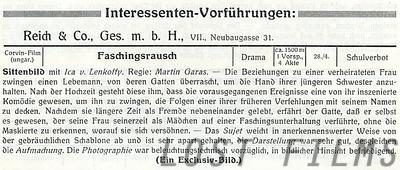|
Farsangi mámor
press document > review
Title
Farsangi mámor (review)
Description
Review from page one of the 311th issue of the Austrian publication, Paimann's Filmlisten. The issue covered the previews of coming attractions, which took place in the capital city Vienna between 16th and 22nd March 1922. Farsangi mámor was rated an "exclusive picture", the meaning of which is explained in detail below. The remark "Schulverbot" refers to the Viennese censor's decision to forbid screenings of the film to people of school age (i.e. children and youths). "28./4." refers to the date on which the film would then be officially released in Vienna. Paimann's Filmlisten - sub-headed "Wochenschrift für Lichtbild-Kritik" - was an Austrian cinema trade magazine that started weekly publication from January 1916. The magazine was named after its founder and first editor, Franz Paimann. At the beginning the magazine was sent out every week to cinema owners in Austria (later it became subscription-only) to alert them to the latest coming attractions. A paragraph was devoted to each film providing both a short summary and a critique. The critique would judge specific elements, such as the acting and cinematography. An overall rating was then applied to the film following a specific schema. From late 1921, the magazine editors employed six categories for rating the films (here listed in order of best to worst): (i) Schlager ersten Ranges (First-rate Smash Hit), (ii) Schlager (Smash Hit), (iii) Exclusiv-Bild (Exclusive Picture), (iv) Ausgezeichnet (Excellent), (v) Sehr gut (Very Good), (vi) Mittelmäßig (Middle-rate). As the first two categories referred to both the artistic merit and popularity of the film in question, a film rated in the third category could still be considered a film of the highest artistic quality without presuming it would draw a large crowd. That Paimann's Filmlisten not only advertised but also honestly reviewed the films in this way made it something of a unique offering amongst the trade journals of the time, which were mostly controlled by film producers and exhibitors to shamelessly promote every film on offer. Inevitably this made Paimann's Filmlisten very unpopular amongst the Austrian film producers and exhibitors. Such was their fear that this kind of criticism would lead to lower earnings at the box office that in April 1923 they began a long running (and untimately unsuccessful) attempt to boycott the publication. In 1943 publication of Paimann's Filmlisten was temporarily halted due to scarcity of raw materials during wartime. In 1946 it resumed publication, continuing until 1965. Paolo Caneppele / Oliver Hanley, 06.12.2010 Selected literature (all links still active as of the publication date) * Paolo Caneppele (ed.), Materialien zur österreichischen Filmgeschichte 8: Entscheidungen der Wiener Filmzensur 1922–1925, Vienna: Verlag Filmarchiv Austria, 2002
Id number
PFL_Jg7_Nr311_s01
Classification
press document > review |
 |